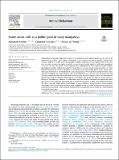Files in this item
Snake alarm calls as a public good in sooty mangabeys
Item metadata
| dc.contributor.author | Mielke, Alexander | |
| dc.contributor.author | Crockford, Catherine | |
| dc.contributor.author | Wittig, Roman M | |
| dc.date.accessioned | 2021-11-30T11:30:10Z | |
| dc.date.available | 2021-11-30T11:30:10Z | |
| dc.date.issued | 2019-12 | |
| dc.identifier | 276613956 | |
| dc.identifier | 28379bd1-864b-4148-8483-99a56339acc5 | |
| dc.identifier | 85075283889 | |
| dc.identifier.citation | Mielke , A , Crockford , C & Wittig , R M 2019 , ' Snake alarm calls as a public good in sooty mangabeys ' , Animal Behaviour , vol. 158 , pp. 201-209 . https://doi.org/10.1016/j.anbehav.2019.10.001 | en |
| dc.identifier.issn | 0003-3472 | |
| dc.identifier.other | Bibtex: mielke2019snake | |
| dc.identifier.uri | https://hdl.handle.net/10023/24436 | |
| dc.description | Core funding for TCP has been provided by the Max Planck Society since 1997. | en |
| dc.description.abstract | Transmitting information about the location of a predator in social animal species can be seen as an investment in a public good, where information is the resource and group members benefit from reduced fatalities of kin and cooperation partners in their community. As few empirical tests of this idea exist in natural settings, we conducted a field experiment using snake models in wild sooty mangabeys, Cercocebus atys atys. We tested sooty mangabey alarm-calling patterns when exposed to viper models, investigating whether individuals called to signal fitness, to warn specific group members, or when information about the threat is not public, as would be predicted by public goods games. Strong interindividual differences in the likelihood of alarm calling existed. We found that overlap between callers was rare. Individuals were more likely to call if fewer individuals were present at the encounter site and if they had not heard other alarm calls before arriving at the site, indicating that alarm calls extended the information about the threat to following group members. This group size effect is in line with predictions of the volunteer's dilemma, a public goods game. We found no indications that individuals called specifically to warn ignorant individuals, kin or cooperation partners. Calling when information about the threat was not public allowed individuals to warn following group members while avoiding redundancy. Public goods games have not been employed widely in studies of the evolution of primate cooperation and animal communication in general but may provide useful models for understanding group level cooperation. | |
| dc.format.extent | 9 | |
| dc.format.extent | 498895 | |
| dc.language.iso | eng | |
| dc.relation.ispartof | Animal Behaviour | en |
| dc.subject | Public goods game | en |
| dc.subject | Sooty mangabey | en |
| dc.subject | Alarm call | en |
| dc.subject | Cooperation | en |
| dc.subject | Predator | en |
| dc.subject | BF Psychology | en |
| dc.subject | NDAS | en |
| dc.subject.lcc | BF | en |
| dc.title | Snake alarm calls as a public good in sooty mangabeys | en |
| dc.type | Journal article | en |
| dc.contributor.institution | University of St Andrews. School of Psychology and Neuroscience | en |
| dc.identifier.doi | 10.1016/j.anbehav.2019.10.001 | |
| dc.description.status | Peer reviewed | en |
This item appears in the following Collection(s)
Items in the St Andrews Research Repository are protected by copyright, with all rights reserved, unless otherwise indicated.

